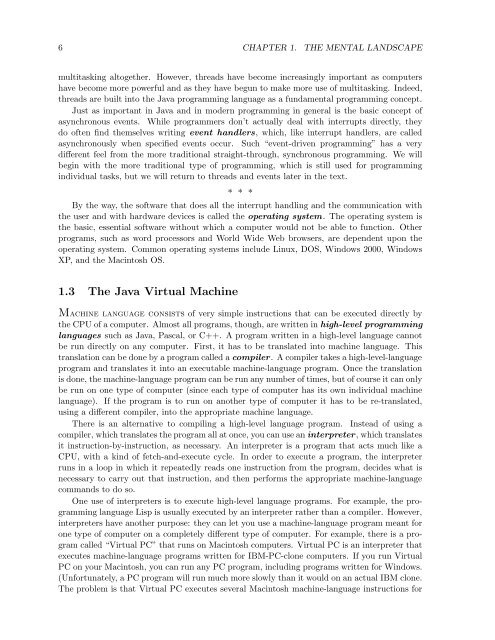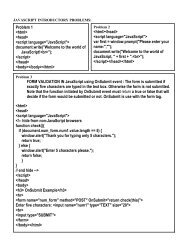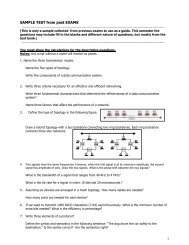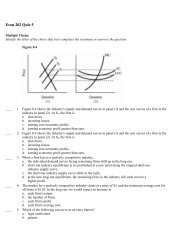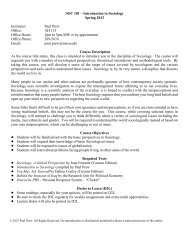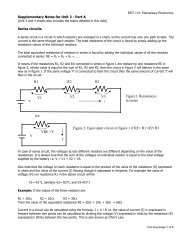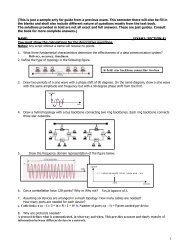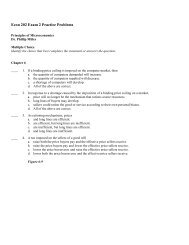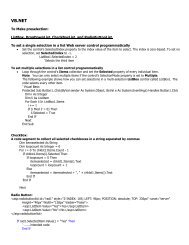- Page 6 and 7: viCONTENTS5.5 Inheritance and Polym
- Page 8 and 9: viiiCONTENTS7.5 Multi-dimensional A
- Page 10 and 11: xCONTENTS11.1.5 The Scanner Class .
- Page 12 and 13: xiiCONTENTS
- Page 14 and 15: xivPrefaceChapter 7. Chapter 8 mark
- Page 16 and 17: xviPreface
- Page 18 and 19: 2 CHAPTER 1. THE MENTAL LANDSCAPElo
- Page 20 and 21: 4 CHAPTER 1. THE MENTAL LANDSCAPE
- Page 24 and 25: 8 CHAPTER 1. THE MENTAL LANDSCAPE
- Page 26 and 27: 10 CHAPTER 1. THE MENTAL LANDSCAPEt
- Page 28 and 29: DrawableObjectTwoPointObject Multip
- Page 30 and 31: JComponentJAbstractButton JComboBox
- Page 32 and 33: 16 CHAPTER 1. THE MENTAL LANDSCAPEi
- Page 34 and 35: 18 CHAPTER 1. THE MENTAL LANDSCAPE
- Page 36 and 37: 20 CHAPTER 2. NAMES AND THINGScan b
- Page 38 and 39: 22 CHAPTER 2. NAMES AND THINGSscrip
- Page 40 and 41: 24 CHAPTER 2. NAMES AND THINGSprogr
- Page 42 and 43: 26 CHAPTER 2. NAMES AND THINGSbe us
- Page 44 and 45: 28 CHAPTER 2. NAMES AND THINGSdoubl
- Page 46 and 47: 30 CHAPTER 2. NAMES AND THINGStype
- Page 48 and 49: 32 CHAPTER 2. NAMES AND THINGSthan
- Page 50 and 51: 34 CHAPTER 2. NAMES AND THINGSbegin
- Page 52 and 53: 36 CHAPTER 2. NAMES AND THINGSpubli
- Page 54 and 55: 38 CHAPTER 2. NAMES AND THINGSWhen
- Page 56 and 57: 40 CHAPTER 2. NAMES AND THINGSthan
- Page 58 and 59: 42 CHAPTER 2. NAMES AND THINGSare t
- Page 60 and 61: 44 CHAPTER 2. NAMES AND THINGS}}Str
- Page 62 and 63: 46 CHAPTER 2. NAMES AND THINGSFor e
- Page 64 and 65: 48 CHAPTER 2. NAMES AND THINGSSuppo
- Page 66 and 67: 50 CHAPTER 2. NAMES AND THINGS2.5.7
- Page 68 and 69: 52 CHAPTER 2. NAMES AND THINGS2.6.2
- Page 70 and 71: 54 CHAPTER 2. NAMES AND THINGSthe f
- Page 72 and 73:
56 CHAPTER 2. NAMES AND THINGSin th
- Page 74 and 75:
58 CHAPTER 2. NAMES AND THINGSExerc
- Page 76 and 77:
60 CHAPTER 2. NAMES AND THINGSQuiz
- Page 78 and 79:
62 CHAPTER 3. CONTROLThat is, it co
- Page 80 and 81:
64 CHAPTER 3. CONTROLpublic class I
- Page 82 and 83:
66 CHAPTER 3. CONTROLSystem.out.pri
- Page 84 and 85:
68 CHAPTER 3. CONTROLtime we proces
- Page 86 and 87:
70 CHAPTER 3. CONTROLIn order to co
- Page 88 and 89:
72 CHAPTER 3. CONTROLTextIO.putln(N
- Page 90 and 91:
74 CHAPTER 3. CONTROLthat were intr
- Page 92 and 93:
76 CHAPTER 3. CONTROLcount = 0;/* R
- Page 94 and 95:
78 CHAPTER 3. CONTROLSimilarly,〈d
- Page 96 and 97:
80 CHAPTER 3. CONTROL3.4.1 For Loop
- Page 98 and 99:
82 CHAPTER 3. CONTROL(1) // There a
- Page 100 and 101:
84 CHAPTER 3. CONTROLFinally, we ca
- Page 102 and 103:
86 CHAPTER 3. CONTROL}System.out.pr
- Page 104 and 105:
88 CHAPTER 3. CONTROLThe enhanced f
- Page 106 and 107:
90 CHAPTER 3. CONTROLif (〈boolean
- Page 108 and 109:
92 CHAPTER 3. CONTROL}System.out.pr
- Page 110 and 111:
94 CHAPTER 3. CONTROLTextIO.putln("
- Page 112 and 113:
96 CHAPTER 3. CONTROLWhy? Because t
- Page 114 and 115:
98 CHAPTER 3. CONTROLTextIO.putln("
- Page 116 and 117:
100 CHAPTER 3. CONTROLto replace th
- Page 118 and 119:
102 CHAPTER 3. CONTROLAs an example
- Page 120 and 121:
104 CHAPTER 3. CONTROL}}count = 0;t
- Page 122 and 123:
106 CHAPTER 3. CONTROLof the class)
- Page 124 and 125:
108 CHAPTER 3. CONTROLrectHeight =
- Page 126 and 127:
110 CHAPTER 3. CONTROLheight = getH
- Page 128 and 129:
112 CHAPTER 3. CONTROL5. Suppose th
- Page 130 and 131:
114 CHAPTER 3. CONTROLQuiz on Chapt
- Page 132 and 133:
116 CHAPTER 3. CONTROL
- Page 134 and 135:
118 CHAPTER 4. SUBROUTINESThe inter
- Page 136 and 137:
120 CHAPTER 4. SUBROUTINESas discus
- Page 138 and 139:
122 CHAPTER 4. SUBROUTINESThe use o
- Page 140 and 141:
124 CHAPTER 4. SUBROUTINESboolean p
- Page 142 and 143:
126 CHAPTER 4. SUBROUTINESHere’s
- Page 144 and 145:
128 CHAPTER 4. SUBROUTINES}count++;
- Page 146 and 147:
130 CHAPTER 4. SUBROUTINESnot inclu
- Page 148 and 149:
132 CHAPTER 4. SUBROUTINES/*** Writ
- Page 150 and 151:
134 CHAPTER 4. SUBROUTINESas oppose
- Page 152 and 153:
136 CHAPTER 4. SUBROUTINESstatic in
- Page 154 and 155:
138 CHAPTER 4. SUBROUTINES}// Appen
- Page 156 and 157:
140 CHAPTER 4. SUBROUTINES4.5 APIs,
- Page 158 and 159:
awt util Math Graphics sqrt() lang
- Page 160 and 161:
144 CHAPTER 4. SUBROUTINESThis woul
- Page 162 and 163:
146 CHAPTER 4. SUBROUTINES}double a
- Page 164 and 165:
148 CHAPTER 4. SUBROUTINES* wide an
- Page 166 and 167:
150 CHAPTER 4. SUBROUTINESI need to
- Page 168 and 169:
152 CHAPTER 4. SUBROUTINES/*** This
- Page 170 and 171:
154 CHAPTER 4. SUBROUTINES4.7.1 Ini
- Page 172 and 173:
156 CHAPTER 4. SUBROUTINESSimilarly
- Page 174 and 175:
158 CHAPTER 4. SUBROUTINEScurrentRo
- Page 176 and 177:
160 CHAPTER 4. SUBROUTINES}}int x;
- Page 178 and 179:
162 CHAPTER 4. SUBROUTINESa paramet
- Page 180 and 181:
164 CHAPTER 4. SUBROUTINESQuiz on C
- Page 182 and 183:
166 CHAPTER 5. OBJECTS AND CLASSES5
- Page 184 and 185:
168 CHAPTER 5. OBJECTS AND CLASSESp
- Page 186 and 187:
170 CHAPTER 5. OBJECTS AND CLASSESA
- Page 188 and 189:
172 CHAPTER 5. OBJECTS AND CLASSESo
- Page 190 and 191:
174 CHAPTER 5. OBJECTS AND CLASSES}
- Page 192 and 193:
176 CHAPTER 5. OBJECTS AND CLASSESp
- Page 194 and 195:
178 CHAPTER 5. OBJECTS AND CLASSES4
- Page 196 and 197:
180 CHAPTER 5. OBJECTS AND CLASSESO
- Page 198 and 199:
182 CHAPTER 5. OBJECTS AND CLASSESI
- Page 200 and 201:
184 CHAPTER 5. OBJECTS AND CLASSESF
- Page 202 and 203:
186 CHAPTER 5. OBJECTS AND CLASSESt
- Page 204 and 205:
188 CHAPTER 5. OBJECTS AND CLASSESA
- Page 206 and 207:
190 CHAPTER 5. OBJECTS AND CLASSES*
- Page 208 and 209:
192 CHAPTER 5. OBJECTS AND CLASSESd
- Page 210 and 211:
194 CHAPTER 5. OBJECTS AND CLASSEST
- Page 212 and 213:
196 CHAPTER 5. OBJECTS AND CLASSESE
- Page 214 and 215:
198 CHAPTER 5. OBJECTS AND CLASSESa
- Page 216 and 217:
200 CHAPTER 5. OBJECTS AND CLASSES5
- Page 218 and 219:
202 CHAPTER 5. OBJECTS AND CLASSEST
- Page 220 and 221:
204 CHAPTER 5. OBJECTS AND CLASSESp
- Page 222 and 223:
206 CHAPTER 5. OBJECTS AND CLASSESo
- Page 224 and 225:
208 CHAPTER 5. OBJECTS AND CLASSEST
- Page 226 and 227:
210 CHAPTER 5. OBJECTS AND CLASSESS
- Page 228 and 229:
212 CHAPTER 5. OBJECTS AND CLASSESl
- Page 230 and 231:
214 CHAPTER 5. OBJECTS AND CLASSESn
- Page 232 and 233:
216 CHAPTER 5. OBJECTS AND CLASSES}
- Page 234 and 235:
218 CHAPTER 5. OBJECTS AND CLASSESA
- Page 236 and 237:
220 CHAPTER 5. OBJECTS AND CLASSESE
- Page 238 and 239:
222 CHAPTER 5. OBJECTS AND CLASSESw
- Page 240 and 241:
224 CHAPTER 5. OBJECTS AND CLASSESC
- Page 242 and 243:
226 CHAPTER 6. INTRODUCTION TO GUI
- Page 244 and 245:
228 CHAPTER 6. INTRODUCTION TO GUI
- Page 246 and 247:
230 CHAPTER 6. INTRODUCTION TO GUI
- Page 248 and 249:
232 CHAPTER 6. INTRODUCTION TO GUI
- Page 250 and 251:
234 CHAPTER 6. INTRODUCTION TO GUI
- Page 252 and 253:
236 CHAPTER 6. INTRODUCTION TO GUI
- Page 254 and 255:
238 CHAPTER 6. INTRODUCTION TO GUI
- Page 256 and 257:
240 CHAPTER 6. INTRODUCTION TO GUI
- Page 258 and 259:
242 CHAPTER 6. INTRODUCTION TO GUI
- Page 260 and 261:
244 CHAPTER 6. INTRODUCTION TO GUI
- Page 262 and 263:
246 CHAPTER 6. INTRODUCTION TO GUI
- Page 264 and 265:
248 CHAPTER 6. INTRODUCTION TO GUI
- Page 266 and 267:
250 CHAPTER 6. INTRODUCTION TO GUI
- Page 268 and 269:
252 CHAPTER 6. INTRODUCTION TO GUI
- Page 270 and 271:
254 CHAPTER 6. INTRODUCTION TO GUI
- Page 272 and 273:
256 CHAPTER 6. INTRODUCTION TO GUI
- Page 274 and 275:
258 CHAPTER 6. INTRODUCTION TO GUI
- Page 276 and 277:
260 CHAPTER 6. INTRODUCTION TO GUI
- Page 278 and 279:
262 CHAPTER 6. INTRODUCTION TO GUI
- Page 280 and 281:
264 CHAPTER 6. INTRODUCTION TO GUI
- Page 282 and 283:
266 CHAPTER 6. INTRODUCTION TO GUI
- Page 284 and 285:
268 CHAPTER 6. INTRODUCTION TO GUI
- Page 286 and 287:
270 CHAPTER 6. INTRODUCTION TO GUI
- Page 288 and 289:
272 CHAPTER 6. INTRODUCTION TO GUI
- Page 290 and 291:
274 CHAPTER 6. INTRODUCTION TO GUI
- Page 292 and 293:
276 CHAPTER 6. INTRODUCTION TO GUI
- Page 294 and 295:
278 CHAPTER 6. INTRODUCTION TO GUI
- Page 296 and 297:
280 CHAPTER 6. INTRODUCTION TO GUI
- Page 298 and 299:
282 CHAPTER 6. INTRODUCTION TO GUI
- Page 300 and 301:
284 CHAPTER 6. INTRODUCTION TO GUI
- Page 302 and 303:
286 CHAPTER 6. INTRODUCTION TO GUI
- Page 304 and 305:
288 CHAPTER 6. INTRODUCTION TO GUI
- Page 306 and 307:
290 CHAPTER 6. INTRODUCTION TO GUI
- Page 308 and 309:
292 CHAPTER 6. INTRODUCTION TO GUI
- Page 310 and 311:
294 CHAPTER 6. INTRODUCTION TO GUI
- Page 312 and 313:
296 CHAPTER 6. INTRODUCTION TO GUI
- Page 314 and 315:
298 CHAPTER 6. INTRODUCTION TO GUI
- Page 316 and 317:
300 CHAPTER 6. INTRODUCTION TO GUI
- Page 318 and 319:
302 CHAPTER 6. INTRODUCTION TO GUI
- Page 320 and 321:
304 CHAPTER 6. INTRODUCTION TO GUI
- Page 322 and 323:
306 CHAPTER 6. INTRODUCTION TO GUI
- Page 324 and 325:
308 CHAPTER 6. INTRODUCTION TO GUI
- Page 326 and 327:
310 CHAPTER 6. INTRODUCTION TO GUI
- Page 328 and 329:
312 CHAPTER 6. INTRODUCTION TO GUI
- Page 330 and 331:
314 CHAPTER 7. ARRAYS}int id number
- Page 332 and 333:
316 CHAPTER 7. ARRAYSNote that the
- Page 334 and 335:
318 CHAPTER 7. ARRAYSint[] primes =
- Page 336 and 337:
320 CHAPTER 7. ARRAYS(There is one
- Page 338 and 339:
322 CHAPTER 7. ARRAYS}return null;d
- Page 340 and 341:
324 CHAPTER 7. ARRAYS} // end birth
- Page 342 and 343:
326 CHAPTER 7. ARRAYSpublic void pa
- Page 344 and 345:
328 CHAPTER 7. ARRAYSvariable arity
- Page 346 and 347:
330 CHAPTER 7. ARRAYSorder. (This i
- Page 348 and 349:
shapes.length shapes[0] shapes332 C
- Page 350 and 351:
334 CHAPTER 7. ARRAYS*/public int g
- Page 352 and 353:
336 CHAPTER 7. ARRAYS• list.size(
- Page 354 and 355:
338 CHAPTER 7. ARRAYSIf g is a vari
- Page 356 and 357:
340 CHAPTER 7. ARRAYStype ArrayList
- Page 358 and 359:
342 CHAPTER 7. ARRAYS// Draw a line
- Page 360 and 361:
344 CHAPTER 7. ARRAYS* Searches the
- Page 362 and 363:
346 CHAPTER 7. ARRAYSassociates a p
- Page 364 and 365:
348 CHAPTER 7. ARRAYSit’s really
- Page 366 and 367:
350 CHAPTER 7. ARRAYSstatic void se
- Page 368 and 369:
352 CHAPTER 7. ARRAYS}for (int last
- Page 370 and 371:
354 CHAPTER 7. ARRAYSfollow the sam
- Page 372 and 373:
356 CHAPTER 7. ARRAYSdouble totalPr
- Page 374 and 375:
BLACK BLACK BLACK BLACK 1 BLACK BLA
- Page 376 and 377:
360 CHAPTER 7. ARRAYS/*** Return an
- Page 378 and 379:
362 CHAPTER 7. ARRAYS*/private bool
- Page 380 and 381:
364 CHAPTER 7. ARRAYSExercises for
- Page 382 and 383:
366 CHAPTER 7. ARRAYSIf ball is a v
- Page 384 and 385:
368 CHAPTER 7. ARRAYS}word += "\’
- Page 386 and 387:
370 CHAPTER 7. ARRAYSQuiz on Chapte
- Page 388 and 389:
372 CHAPTER 7. ARRAYS
- Page 390 and 391:
374 CHAPTER 8. CORRECTNESS AND ROBU
- Page 392 and 393:
376 CHAPTER 8. CORRECTNESS AND ROBU
- Page 394 and 395:
378 CHAPTER 8. CORRECTNESS AND ROBU
- Page 396 and 397:
380 CHAPTER 8. CORRECTNESS AND ROBU
- Page 398 and 399:
382 CHAPTER 8. CORRECTNESS AND ROBU
- Page 400 and 401:
384 CHAPTER 8. CORRECTNESS AND ROBU
- Page 402 and 403:
386 CHAPTER 8. CORRECTNESS AND ROBU
- Page 404 and 405:
388 CHAPTER 8. CORRECTNESS AND ROBU
- Page 406 and 407:
390 CHAPTER 8. CORRECTNESS AND ROBU
- Page 408 and 409:
392 CHAPTER 8. CORRECTNESS AND ROBU
- Page 410 and 411:
394 CHAPTER 8. CORRECTNESS AND ROBU
- Page 412 and 413:
396 CHAPTER 8. CORRECTNESS AND ROBU
- Page 414 and 415:
398 CHAPTER 8. CORRECTNESS AND ROBU
- Page 416 and 417:
400 CHAPTER 8. CORRECTNESS AND ROBU
- Page 418 and 419:
402 CHAPTER 8. CORRECTNESS AND ROBU
- Page 420 and 421:
404 CHAPTER 8. CORRECTNESS AND ROBU
- Page 422 and 423:
406 CHAPTER 8. CORRECTNESS AND ROBU
- Page 424 and 425:
408 CHAPTER 8. CORRECTNESS AND ROBU
- Page 426 and 427:
410 CHAPTER 8. CORRECTNESS AND ROBU
- Page 428 and 429:
412 CHAPTER 8. CORRECTNESS AND ROBU
- Page 430 and 431:
414 CHAPTER 8. CORRECTNESS AND ROBU
- Page 432 and 433:
416 CHAPTER 8. CORRECTNESS AND ROBU
- Page 434 and 435:
418 CHAPTER 8. CORRECTNESS AND ROBU
- Page 436 and 437:
420 CHAPTER 8. CORRECTNESS AND ROBU
- Page 438 and 439:
422 CHAPTER 8. CORRECTNESS AND ROBU
- Page 440 and 441:
424 CHAPTER 8. CORRECTNESS AND ROBU
- Page 442 and 443:
426 CHAPTER 8. CORRECTNESS AND ROBU
- Page 444 and 445:
428 CHAPTER 9. LINKED DATA STRUCTUR
- Page 446 and 447:
430 CHAPTER 9. LINKED DATA STRUCTUR
- Page 448 and 449:
432 CHAPTER 9. LINKED DATA STRUCTUR
- Page 450 and 451:
434 CHAPTER 9. LINKED DATA STRUCTUR
- Page 452 and 453:
436 CHAPTER 9. LINKED DATA STRUCTUR
- Page 454 and 455:
438 CHAPTER 9. LINKED DATA STRUCTUR
- Page 456 and 457:
Whenanobjectcontainsareferencetoano
- Page 458 and 459:
442 CHAPTER 9. LINKED DATA STRUCTUR
- Page 460 and 461:
444 CHAPTER 9. LINKED DATA STRUCTUR
- Page 462 and 463:
446 CHAPTER 9. LINKED DATA STRUCTUR
- Page 464 and 465:
448 CHAPTER 9. LINKED DATA STRUCTUR
- Page 466 and 467:
450 CHAPTER 9. LINKED DATA STRUCTUR
- Page 468 and 469:
ortheother.The"enqueue"operationadd
- Page 470 and 471:
454 CHAPTER 9. LINKED DATA STRUCTUR
- Page 472 and 473:
456 CHAPTER 9. LINKED DATA STRUCTUR
- Page 474 and 475:
458 CHAPTER 9. LINKED DATA STRUCTUR
- Page 476 and 477:
RootNode412 3 null 56460 CHAPTER 9.
- Page 478 and 479:
462 CHAPTER 9. LINKED DATA STRUCTUR
- Page 480 and 481:
464 CHAPTER 9. LINKED DATA STRUCTUR
- Page 482 and 483:
466 CHAPTER 9. LINKED DATA STRUCTUR
- Page 484 and 485:
468 CHAPTER 9. LINKED DATA STRUCTUR
- Page 486 and 487:
470 CHAPTER 9. LINKED DATA STRUCTUR
- Page 488 and 489:
472 CHAPTER 9. LINKED DATA STRUCTUR
- Page 490 and 491:
474 CHAPTER 9. LINKED DATA STRUCTUR
- Page 492 and 493:
476 CHAPTER 9. LINKED DATA STRUCTUR
- Page 494 and 495:
478 CHAPTER 9. LINKED DATA STRUCTUR
- Page 496 and 497:
480 CHAPTER 9. LINKED DATA STRUCTUR
- Page 498 and 499:
482 CHAPTER 9. LINKED DATA STRUCTUR
- Page 500 and 501:
484 CHAPTER 9. LINKED DATA STRUCTUR
- Page 502 and 503:
486 CHAPTER 10. GENERIC PROGRAMMING
- Page 504 and 505:
488 CHAPTER 10. GENERIC PROGRAMMING
- Page 506 and 507:
490 CHAPTER 10. GENERIC PROGRAMMING
- Page 508 and 509:
492 CHAPTER 10. GENERIC PROGRAMMING
- Page 510 and 511:
494 CHAPTER 10. GENERIC PROGRAMMING
- Page 512 and 513:
496 CHAPTER 10. GENERIC PROGRAMMING
- Page 514 and 515:
498 CHAPTER 10. GENERIC PROGRAMMING
- Page 516 and 517:
500 CHAPTER 10. GENERIC PROGRAMMING
- Page 518 and 519:
502 CHAPTER 10. GENERIC PROGRAMMING
- Page 520 and 521:
504 CHAPTER 10. GENERIC PROGRAMMING
- Page 522 and 523:
506 CHAPTER 10. GENERIC PROGRAMMING
- Page 524 and 525:
508 CHAPTER 10. GENERIC PROGRAMMING
- Page 526 and 527:
2345678901item itemitem item item i
- Page 528 and 529:
512 CHAPTER 10. GENERIC PROGRAMMING
- Page 530 and 531:
514 CHAPTER 10. GENERIC PROGRAMMING
- Page 532 and 533:
516 CHAPTER 10. GENERIC PROGRAMMING
- Page 534 and 535:
518 CHAPTER 10. GENERIC PROGRAMMING
- Page 536 and 537:
520 CHAPTER 10. GENERIC PROGRAMMING
- Page 538 and 539:
522 CHAPTER 10. GENERIC PROGRAMMING
- Page 540 and 541:
524 CHAPTER 10. GENERIC PROGRAMMING
- Page 542 and 543:
526 CHAPTER 10. GENERIC PROGRAMMING
- Page 544 and 545:
528 CHAPTER 10. GENERIC PROGRAMMING
- Page 546 and 547:
530 CHAPTER 10. GENERIC PROGRAMMING
- Page 548 and 549:
532 CHAPTER 10. GENERIC PROGRAMMING
- Page 550 and 551:
534 CHAPTER 10. GENERIC PROGRAMMING
- Page 552 and 553:
536 CHAPTER 10. GENERIC PROGRAMMING
- Page 554 and 555:
538 CHAPTER 11. FILES AND NETWORKIN
- Page 556 and 557:
540 CHAPTER 11. FILES AND NETWORKIN
- Page 558 and 559:
542 CHAPTER 11. FILES AND NETWORKIN
- Page 560 and 561:
544 CHAPTER 11. FILES AND NETWORKIN
- Page 562 and 563:
546 CHAPTER 11. FILES AND NETWORKIN
- Page 564 and 565:
548 CHAPTER 11. FILES AND NETWORKIN
- Page 566 and 567:
550 CHAPTER 11. FILES AND NETWORKIN
- Page 568 and 569:
552 CHAPTER 11. FILES AND NETWORKIN
- Page 570 and 571:
554 CHAPTER 11. FILES AND NETWORKIN
- Page 572 and 573:
556 CHAPTER 11. FILES AND NETWORKIN
- Page 574 and 575:
558 CHAPTER 11. FILES AND NETWORKIN
- Page 576 and 577:
560 CHAPTER 11. FILES AND NETWORKIN
- Page 578 and 579:
562 CHAPTER 11. FILES AND NETWORKIN
- Page 580 and 581:
564 CHAPTER 11. FILES AND NETWORKIN
- Page 582 and 583:
566 CHAPTER 11. FILES AND NETWORKIN
- Page 584 and 585:
568 CHAPTER 11. FILES AND NETWORKIN
- Page 586 and 587:
570 CHAPTER 11. FILES AND NETWORKIN
- Page 588 and 589:
572 CHAPTER 11. FILES AND NETWORKIN
- Page 590 and 591:
574 CHAPTER 11. FILES AND NETWORKIN
- Page 592 and 593:
576 CHAPTER 11. FILES AND NETWORKIN
- Page 594 and 595:
578 CHAPTER 11. FILES AND NETWORKIN
- Page 596 and 597:
580 CHAPTER 11. FILES AND NETWORKIN
- Page 598 and 599:
582 CHAPTER 11. FILES AND NETWORKIN
- Page 600 and 601:
584 CHAPTER 11. FILES AND NETWORKIN
- Page 602 and 603:
586 CHAPTER 11. FILES AND NETWORKIN
- Page 604 and 605:
588 CHAPTER 11. FILES AND NETWORKIN
- Page 606 and 607:
590 CHAPTER 11. FILES AND NETWORKIN
- Page 608 and 609:
592 CHAPTER 11. FILES AND NETWORKIN
- Page 610 and 611:
594 CHAPTER 11. FILES AND NETWORKIN
- Page 612 and 613:
596 CHAPTER 11. FILES AND NETWORKIN
- Page 614 and 615:
598 CHAPTER 11. FILES AND NETWORKIN
- Page 616 and 617:
600 CHAPTER 11. FILES AND NETWORKIN
- Page 618 and 619:
602 CHAPTER 11. FILES AND NETWORKIN
- Page 620 and 621:
604 CHAPTER 11. FILES AND NETWORKIN
- Page 622 and 623:
606 CHAPTER 11. FILES AND NETWORKIN
- Page 624 and 625:
608 CHAPTER 11. FILES AND NETWORKIN
- Page 626 and 627:
610 CHAPTER 11. FILES AND NETWORKIN
- Page 628 and 629:
612 CHAPTER 12. ADVANCED GUI PROGRA
- Page 630 and 631:
614 CHAPTER 12. ADVANCED GUI PROGRA
- Page 632 and 633:
616 CHAPTER 12. ADVANCED GUI PROGRA
- Page 634 and 635:
618 CHAPTER 12. ADVANCED GUI PROGRA
- Page 636 and 637:
620 CHAPTER 12. ADVANCED GUI PROGRA
- Page 638 and 639:
622 CHAPTER 12. ADVANCED GUI PROGRA
- Page 640 and 641:
624 CHAPTER 12. ADVANCED GUI PROGRA
- Page 642 and 643:
626 CHAPTER 12. ADVANCED GUI PROGRA
- Page 644 and 645:
628 CHAPTER 12. ADVANCED GUI PROGRA
- Page 646 and 647:
630 CHAPTER 12. ADVANCED GUI PROGRA
- Page 648 and 649:
632 CHAPTER 12. ADVANCED GUI PROGRA
- Page 650 and 651:
634 CHAPTER 12. ADVANCED GUI PROGRA
- Page 652 and 653:
636 CHAPTER 12. ADVANCED GUI PROGRA
- Page 654 and 655:
638 CHAPTER 12. ADVANCED GUI PROGRA
- Page 656 and 657:
640 CHAPTER 12. ADVANCED GUI PROGRA
- Page 658 and 659:
642 CHAPTER 12. ADVANCED GUI PROGRA
- Page 660 and 661:
644 CHAPTER 12. ADVANCED GUI PROGRA
- Page 662 and 663:
646 CHAPTER 12. ADVANCED GUI PROGRA
- Page 664 and 665:
648 CHAPTER 12. ADVANCED GUI PROGRA
- Page 666 and 667:
650 CHAPTER 12. ADVANCED GUI PROGRA
- Page 668 and 669:
652 CHAPTER 12. ADVANCED GUI PROGRA
- Page 670 and 671:
654 CHAPTER 12. ADVANCED GUI PROGRA
- Page 672 and 673:
656 CHAPTER 12. ADVANCED GUI PROGRA
- Page 674 and 675:
658 CHAPTER 12. ADVANCED GUI PROGRA
- Page 676 and 677:
660 CHAPTER 12. ADVANCED GUI PROGRA
- Page 678 and 679:
662 CHAPTER 12. ADVANCED GUI PROGRA
- Page 680 and 681:
664 CHAPTER 12. ADVANCED GUI PROGRA
- Page 682 and 683:
666 CHAPTER 12. ADVANCED GUI PROGRA
- Page 684 and 685:
668 CHAPTER 12. ADVANCED GUI PROGRA
- Page 686 and 687:
670 CHAPTER 12. ADVANCED GUI PROGRA
- Page 688 and 689:
672 CHAPTER 12. ADVANCED GUI PROGRA
- Page 690 and 691:
674 CHAPTER 12. ADVANCED GUI PROGRA
- Page 692 and 693:
676 Source Code Listingstraightforw
- Page 694 and 695:
678 Source Code Listing• DateClie
- Page 696 and 697:
680 Source Code Listingclicking-and
- Page 698 and 699:
682 Source Code Listing• StopWatc


